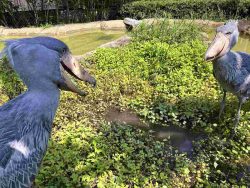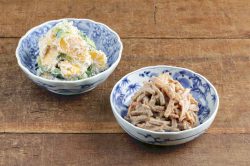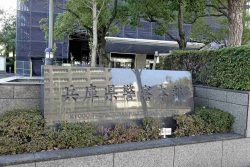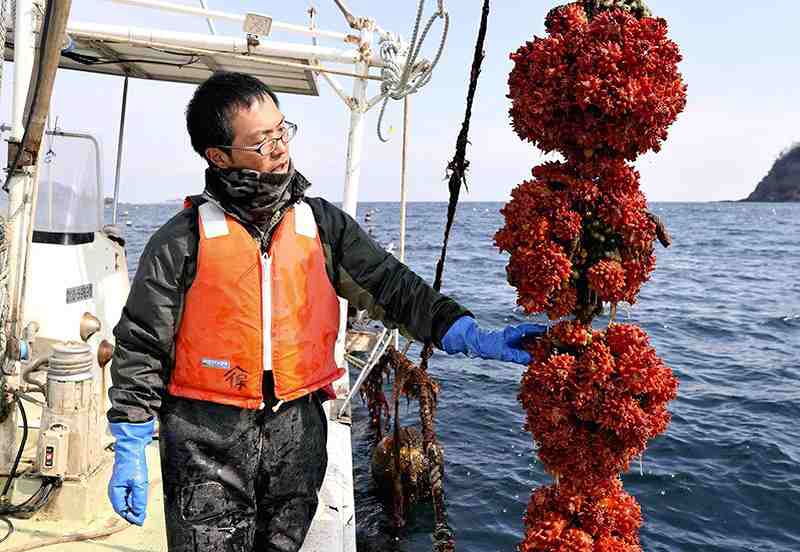
Fisherman Takayuki Atsumi pulls sea squirts out of the sea to check their growth in Ishinomaki, Miyagi Prefecture, on March 1.
13:00 JST, March 11, 2022
SENDAI — Fisherman Takayuki Atsumi was in his late 20s when he saw the huge wave come over the seawall in Ishinomaki, Miyagi Prefecture. He ran toward higher ground but the ferocious speed of the tsunami caught up to him. Desperately, he managed to get onto the roof of a shed floating in the waves.
Atsumi washed up on the slope of a mountain on that day, March 11, 2011. Looking at the view below him, he saw that all the residences in the Yagawahama district of the city had been washed away.
It has been 11 years since the disaster.
Earlier this month, Atsumi, now 39, was operating a fishing boat off the port of Yagawahama, where a new seawall and quay have been built.
He pulled from the water a longline with what seemed like red fruits growing in bunches on it.
“They taste good when deep-fried as tempura,” Atsumi said.
These fruits of the sea are sea squirts, a specialty of the Tohoku region. Called “hoya” in Japanese, they are a delicacy, said to offer all five taste sensations: sweet, sour, salty, bitter and umami. From the look of things, they have grown well this season.
The Yagawahama district faces Samenoura Bay, a valuable marine area where natural sea squirt seeds are harvested. This has allowed the people of the district to actively culture the creatures for many long years. Since the Great East Japan Earthquake, however, this local industry has been facing difficulties.
While the harvest has recovered, South Korea, to which 70% of the total harvest had been exported before the disaster, has imposed an embargo on imports from Japan due to the nuclear accident in Fukushima Prefecture. Some fishermen have been forced to adjust production, with some even giving up on harvesting sea squirts because they see no prospects for the future.
From 2016 to 2017, 15,000 tons of sea squirts, or about 60% of the total harvest in the prefecture, had to be discarded. Fishermen who have to discard sea squirts can receive compensation from Tokyo Electric Power Company Holdings Inc., but Atsumi chose another path.
Rather than discard his sea squirts, he visited restaurants in the Tokyo metropolitan area to expand sales channels. He also sought new ways of handling the sea squirts with other young fishermen and processing companies. After five years of trial and error, they devised a method to keep sea squirts fresh for a longer time after shipment. This year, they will start full-fledged sales of their sea squirts under the registered trade name Senbitoryo Hoya.
“Everyone is now giving up and that is why I want to continue,” Atsumi said.
Finding a path
On Atsumi’s mind is a veteran fisherman who held the local industry together at a time when he almost gave up on fishing due to the earthquake. This person Atsumi admires and follows is Katsuyuki Atsumi, 63, who is his friend’s father and the operating committee chairman of the fishermen’s association in the Yagawahama district.
When Atsumi was in junior high and high school, he spent much of his time with his band. After graduating, he worked part-time in various places such as a pachinko parlor. Then at 21, when he was without a regular job, he said to the veteran fisherman that he wanted to be a fisherman. Atsumi describes the elder fisherman as being exacting at his work but warm-hearted with a hearty laugh. But that day, he reproached Atsumi, saying, “It’s not that easy.”
For three years after that, Atsumi visited fishing ports in various parts of the country and learned the trade by assisting in cod and saury fishing. He returned to his hometown when his wife became pregnant. When Atsumi approached the veteran fisherman again saying he wanted to engage in fishing in the district, Katsuyuki Atsumi encouraged him, saying, “Do your best.”
Reviving local industry
Before the disaster, the Yagawahama district had 167 residents, but in its aftermath, 12 people died and 13 remain missing. Of 62 residential buildings, 60 were destroyed or washed away. Amid such circumstances, residents talked about the possibility of disbanding the community. Atsumi, then 28, left the district and worked as a truck driver for several months in Sendai, where his wife’s parents lived.
During that time Katsuyuki Atsumi cleaned up the destroyed fishing port and collected fishing gear that had washed away and turned up again. In autumn 2011, the veteran fisherman operated his boat that remained and, with the help of fellow fishermen, attempted to obtain sea squirt seeds in the ocean where debris had sunk.
Fortunately, they could obtain the seeds and three years later, sea squirts that grew from the seeds were shipped, the first step to reconstructing the district’s fishing industry.
Young Atsumi resumed fishing using the seeds, becoming a more dependable fisherman year after year.
“I’ve left sea squirts completely in Taka’s hands,” the veteran fisherman said with a smile.
Atsumi has also been given a boost by his family, including his three children born after he became an independent fisherman. His eldest son is 14, his eldest daughter 12 and his second son 8. They now understand their father’s work.
Last autumn, Atsumi took his eldest son sea squirt fishing for the first time. “I don’t mean to make him a fisherman, but I want him to see me doing cool work.”
Atsumi wants to be a fisherman that the next generation in the district can be proud of.
Mixed outlook
Repair of facilities such as fishing ports and fish markets affected by the Great East Japan Earthquake had almost been completed by the end of March 2021. Catches in the affected areas returned to 80% of the pre-disaster level three years after the earthquake, but they have not increased much since then.
Fukushima, Iwate and Miyagi prefectures were severely affected by the quake. In 2018, 14,000 people in these three prefectures were engaged in the fishing industry. While there has been a downward trend in the number of fishermen across the nation, the figure is 40% lower than a decade earlier.
At one point, 55 countries and regions banned certain imports from Japan due to the nuclear accident. The number has now decreased to 14, including China and South Korea.
"Features" POPULAR ARTICLE
-

Sanrio to Open Museum in Yamanashi Pref. Dedicated to Founder, Exhibits Include Hello Kitty, Other Characters
-

Autumn Foliage Surrounds Visitors to Tokyo’s Showa Kinen Park
-

My Daughter No Longer Speaks to Me, But I Want to See Her and My Grandchild
-

Kumamoto: Public Bath Refurbished as Library Where You Can Chat, Take Photos
-
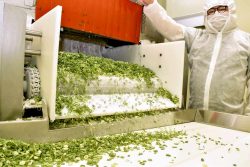
Frozen Vegetables: Demand Rises for Convenient, Tasty Domestic Produce
JN ACCESS RANKING
-

Keidanren Chairman Yoshinobu Tsutsui Visits Kashiwazaki-Kariwa Nuclear Power Plant; Inspects New Emergency Safety System
-

Imports of Rare Earths from China Facing Delays, May Be Caused by Deterioration of Japan-China Relations
-

University of Tokyo Professor Discusses Japanese Economic Security in Interview Ahead of Forum
-

Japan Pulls out of Vietnam Nuclear Project, Complicating Hanoi’s Power Plans
-

Govt Aims to Expand NISA Program Lineup, Abolish Age Restriction



